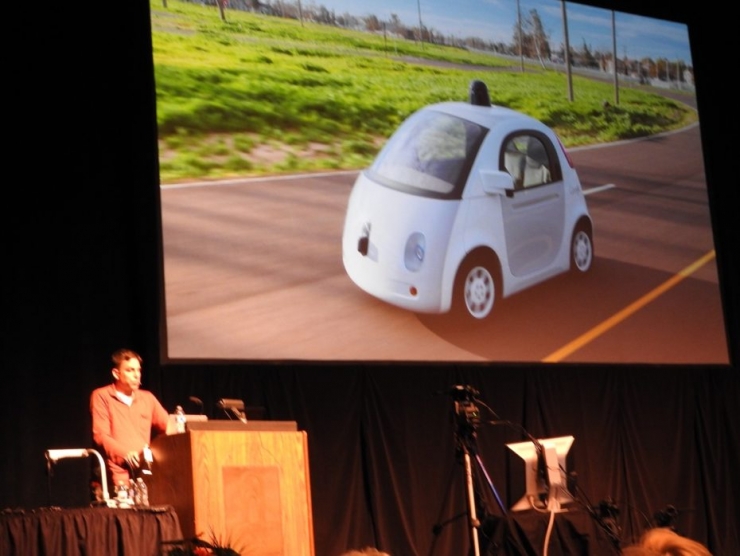Editor's note: This article is based on a presentation by Daniel Rosenband, a hardware engineer at Google’s Autonomous Vehicles Division, at the International High-Performance Microprocessors Conference (Hot Chips) in California. Many speeches at the conference were about the prospects of advanced semiconductors, because now it is no longer a computer or smart phone that blocks the development of electronic devices. Instead, it is a semiconductor chip. The semiconductor chip can assist the car in performing the artificial intelligence algorithm of automatic driving, can run the machine vision software to help the car distinguish pedestrian or bicycle.
 Daniel Rosenband Presents Google’s Self-Driving Cars at the International High-Performance Microprocessor Seminar (Hot Chips)
Daniel Rosenband Presents Google’s Self-Driving Cars at the International High-Performance Microprocessor Seminar (Hot Chips)
Google has always played a leading role in the early days of self-driving cars. Self-driving cars not only lead the innovation of artificial intelligence and machine vision software, but also promote the progress of semiconductor chip technology and hardware systems.
However, Google is just one of the many assists in companies that have driven the development of the $330 billion chip industry. Auto manufacturers such as Tesla, Honda, BMW, Volvo, Mercedes-Benz and Ford are also developing their own self-driving cars. Uber said it will test 100 self-developed self-driving cars in Pittsburgh, while General Motors and Lyft also said that they will begin testing autonomous taxis by the end of the year. Â
 Google’s self-driving cars have had small results in the DARPA Robotics Challenge
Google’s self-driving cars have had small results in the DARPA Robotics Challenge
Automatic driving is the driving force for chip development
Kevin Krewell, an analyst at Tirias Research, called autopilot automotive technology a major driver for the development of semiconductor chips. " Car navigation based on deep learning is different from other high-performance computing work. It is a brand-new way of computing. It is a framework based on new ways." He said that this is why Intel spent $350 million to acquire artificial intelligence. Nervana.
If the semiconductor chip can meet the functional requirements, other supporting systems can also keep up, which will greatly benefit the development of self-driving cars. And when a self-driving car spends 5% of its working time every day for system breaks, the self-driving car will undoubtedly be safer. Rosenband claims that 1.2 million people die every year in car accidents.
“A city has so many people, but a car accident took their lives. In the United States alone, 35,000 people die every year in car accidents. This is equivalent to crashing a passenger aircraft every day. We need to re-examine this. Problem . "
Self-driving cars make it possible for the blind and other physically handicapped people to sit in the driver's seat. However, to build a truly self-driving car that can be used on the road, our technical reserves are still inadequate, and they are long and arduous. Not long ago, a driver activated Tesla's automatic driving function, and the autopilot system could not find that the truck in front caused the driver to die in a car accident.
Even so, each investment company still considers this a promising and safer technology. Rosenband said, "We can change people's lives."
To achieve this goal, we must make unprecedented breakthroughs in artificial intelligence and machine vision. The autopilot system must be able to cope with a wide variety of problems, such as unpredictable traffic conditions, crowded pedestrians and intruding bicycles. This has a very high requirement for the processing power of the system chip, and the final processing mode of the system cannot harm any party.
“When I was driving on the highway, I suddenly realized that we had to deal with the problem: How can we develop a fully automated system?â€
What are the requirements for full autopilot on the hardware?
In an idealized automated driving environment, the system must be able to pick people up at designated locations and send them safely to their destination. The autopilot prototype developed by Google has no steering wheel and can pass through residential areas at speeds of 40km/h or less. It takes a self-protected driving strategy and waits 1.5 seconds before entering the crossroads. In addition, the car can also calculate the possibility of danger.
 Daniel Rosenband, Google's Hardware Engineer
Daniel Rosenband, Google's Hardware Engineer
The vehicle needs to know its own location, the surrounding environment, what the surrounding objects are doing and how the vehicle should move. To meet these requirements requires a lot of map data and sensors. In order to get a 360-degree view of the surroundings of the vehicle, Google uses the Lidar radar system, which can scan the surroundings 360 degrees to generate a 3D model of the vehicle's surroundings. The model shows the distance and speed of different objects.
Rosenband said Google’s next-generation prototype will have four times the computing power of the 2015 prototype. It will be equipped with a multipurpose chip or a custom chip that can handle the problems of self-driving cars. On this 100mm2 chip, it must be able to perform 50 trillion operations per second.
"This is a very large number. Now the chip's computing power has changed dramatically over the past decade. And all this thanks to this group of like-minded programmers."
In response to this challenge, Nvidia said it has developed a brand new chip for self-driving cars, dubbed Parker, which is part of the Drive PX 2 supercomputer for automotive artificial intelligence systems. Intel also claims that its Xeon Phi chip family is also sufficient to handle artificial intelligence issues.
Rosenband said that we still have many problems that need to be solved. For example, sometimes the human eye can't distinguish traffic lights at sunrise or sunset, and it's even harder for the computer to decode images with too high or low exposure, and the vehicle is still moving.
“What kind of environment is the chip suitable for? We have to use several gigahertz radar bands, perform a lot of digital signal processing to reduce noise interference, and reduce the distortion of the radar system. We also use the best silicon materials to play Its maximum performance," said Rosenband.
In the future, Google will most likely need a system that provides the equivalent of a data center on a mobile device. It needs to have the best computing performance without consuming too much power, and the vehicle can read data directly in the data center for calculations.
Why has to be this way? Google’s self-driving car travels 3.2 million kilometers, but it still cannot predict everything that happens in the world. Chris Rowan, a chip expert and director of Cadence Design Systems, said that Google may need to test 1.6 billion kilometers, and its system may include all possible things.
Via venturebeat
Recommended reading:
Depth: Analysis of Core Technology behind Automatic Driving Tesla
An Interview with Carol Reiley, President of Drive.ai: Solving the Problem of Communication between Autonomous Vehicles
RAM/RFM Intermediate Frequency Capacitors
RAM/RFM intermediate frequency capacitors
Intermediate Frequency Capacitors,Induction Heating Capacitors,Furnace Resonant Capacitor
YANGZHOU POSITIONING TECH CO., LTD , https://www.yzpstcc.com